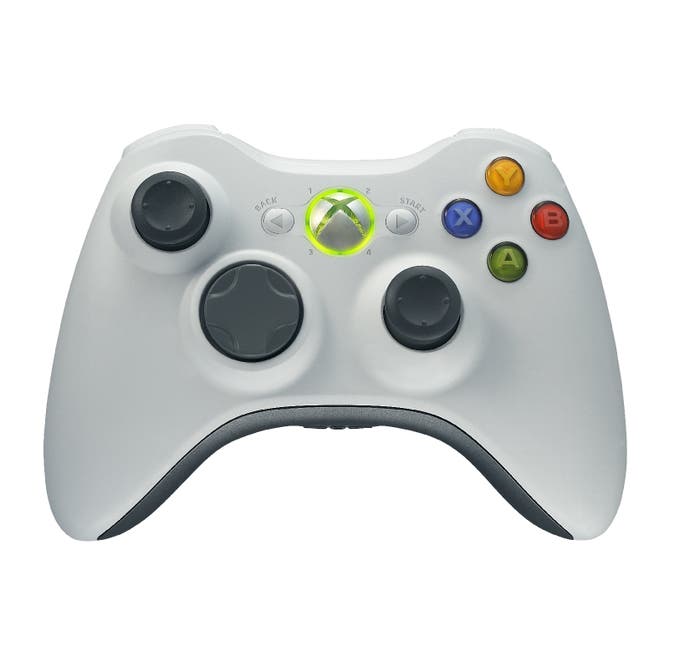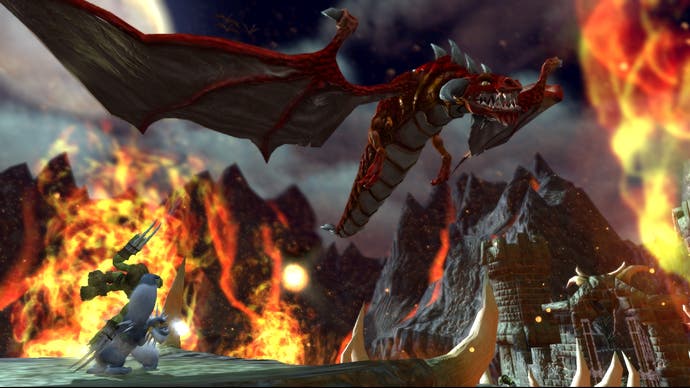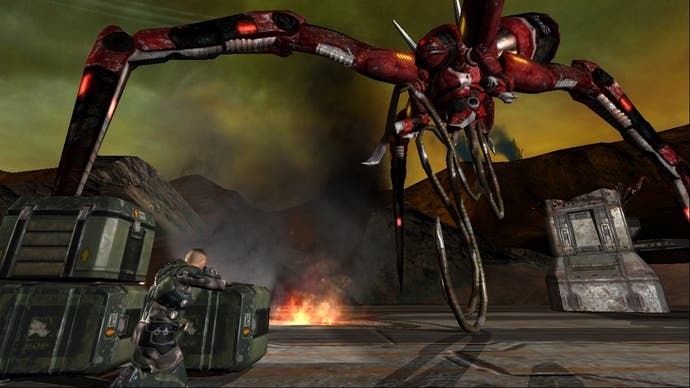Xbox 360: The Lid Is Off
What we've got, what it's got, and what we think.
At last! The next generation cavalry marched into Eurogamer's offices yesterday afternoon, allowing us to finally get up close and personal with Microsoft's eagerly-anticipated new games console. Retail and debug units arrived at the same time and Microsoft's penchant for marketing whimsy is pervasive even now - most evident in the Xbox 360 briefcase, its foam-padded interior snug host to a wireless controller, chargers, remote control, optional controller battery packs and game software. Wrenching the console free of its cardboard packing, it feels roughly as heavy as an Xbox, yet stands unshakably on its base, the solid DVD tray opening invitingly when called upon.
Handling Our Charges
The hard disk - optional and detachable, as you know - comes free when you push down a button towards the front of the unit and lift it at the same time. Doing so reveals an exposed half-inch connector on its underbelly near the front - a potential snag, some might say, but you were going to put it in your jeans pocket anyway, were you?
The controller is much slicker than the Xbox's Controller S, with noticeably slimmer handles, and the repositioning of the Start and Back functions around the central Guide button, and the white and black buttons as Dual Shock-style L1 and R1 triggers is all far more convenient - although you may have to retrain your fingers to reach for them. Analogue triggers are basically the same, and sit behind the white and black buttons (renamed LB and RB) as you look at the pad from the front. Given our tendency to reach for the triggers with our index fingers, LB and RB may prove awkward in games that demand use of all four shoulders, but their intuitive use in, for example, Call of Duty 2 (to lob grenades) suggests it won't be long before we've adjusted.
Then there's the remote control. It's arguably the best reference point for the 360's suite of features and design philosophy - it has most of the controller's buttons, dedicated buttons for Media Center functions and DVD playback, a big Guide button right at the front, and it allows you to turn on, eject the disc tray and operate the console without leaving your couch or straining a wire. It wakes and sleeps as required, glowing green with excitement when you reach for it.

Xbox 360's wires can be largely concealed (you can even plug the controllers into the rear USB ports) or done away with if you go for wireless controllers and the Wi-Fi network adapter, but some are still necessary - and our kit box is a snake pit of cables. The chargers for wireless pads, first, clip snugly onto the top of the controller where Xbox 1 memory units and headsets used to connect - once charged, wireless pads are woken by holding the Guide button for a second, and go to sleep when left alone for a while. The new AV cables (your old ones won't fit) bear chunky connectors - the component offering, in addition to blue/green/red video separates and an optical audio output on its connector, has composite video and stereo audio cables strung from it, and a switch on the connector's underside for alternating between HD-component and TV-composite. We also have SCART and VGA cables. The latter's surely going to be invaluable for people who haven't the cash to spend on HDTVs - allowing for regular RGB gaming in the lounge and pin-sharp high-resolutions in the bedroom or study on a PC monitor or LCD display.
There's been quite a lot said about the power pack, finally, so it's worth noting that the bricklike effort you've probably seen photographed is actually for the debug. The retail unit's power pack is still best described as a brick, but it's about two-thirds as big. Anyway, both can be hidden away easily enough. One last thing to bear in mind though - the PC-style kettle lead that plugs into the brick and runs off to the plug socket isn't a standard one; there's a small ridge that distinguishes it, so don't make the mistake of unplugging one from your PC and making to use that instead (like we tried to!).
Plugs and peripherals aside, the white retail unit is prettier than its dark grey debug counterpart (good news, really - our friends were always outraged by the sight of our sassy translucent Xbox debugs), although it'll be a bit useless until we get boxed games and Microsoft turns on the consumer Xbox Live service. It did allow us to see how Halo looks on 360, though - and that's 'nice, but now quite dated'. The debug is functionally identical to the retail unit, but plays non-final discs in much the same way as Xbox debugs - it also has a slightly different launcher front-end, which appears before you get to the 360's rather swish dashboard, for adjusting low-level tech settings.
A Dashing Beast

The 360 dashboard itself is immediately more engaging, responsive and better thought out than its Xbox progenitor. There's no low hum of noise, for a start, and it's bright and easily navigable by pushing left or right to move between pages (no, we refuse to call them 'blades'). You're immediately invited to transfer an Xbox Live account (a simple procedure), set up a new one, or simply create a profile. Profiles can be swapped over easily at any time by pressing the Guide button on your pad to prompt the Guide overlay (although this is sometimes a little jerky in-game), and the Guide also allows you to view your achievements, and any messages, access your Friends list, and control any audio playback. Guide doesn't appear to be available in Xbox 1 games (it didn't work in Halo anyway), and you should be aware that games tie progress to specific profiles, so you won't want to swap over midway through a level or you'll lose progress.
Guide has plenty of benefits though, the most vaunted and welcome of which is surely gamer defaults. We've talked in the past about being able to invert the Y-axis for all first-person shooters, but you can also turn off auto-aim and the camera's auto-centre, and for driving games you can set a default transmission type, camera angle, and your preferred acceleration and braking controls (the triggers, by default). This kind of centralisation of the tedious procedural aspects of game management is to be applauded.
Moving away from your profile, the System page allows you to adjust all the obvious settings as it did with Xbox, although it goes to greater lengths here. European gamers are finally welcome to play in higher resolutions; there are PAL-50 and 60 options and normal and widescreen toggles as before, but also the three progressive-scan options, 480p, 720p - something all 360 games will have to support - and 1080i. You can also choose your preferred sound setup (for analogue there's Mono or Pro-Logic, for digital there's Stereo, Dolby Digital 5.1 and Dolby Digital with WMA pro), as well as changing language, time, date, location, toggles for the screen-dimmer and auto-power-off, selecting parental controls, and managing storage devices. The System page also lets you fiddle with network settings, both for Live and PC connection.
Connecting the Media

Connectivity with other devices has formed a large part of Microsoft's living room putsch - iPods and PSPs are recognized more or less instantly from the Media page's MP3 and Photo browsers, for example, as should be most third-party USB devices. We tried our Sony Cybershot camera, for example, and although it didn't recognize it as a camera, it was picked up as a generic USB device that we could browse. Support for others and new devices will be added through downloadable updates, we're told. You can't run videos from PSP though, nor iTunes-purchased music from iPods, and - as you may have anticipated - video playback of files stored on PCs is limited to Windows XP Service Pack 2-equipped machines with Media Center Extender, and Media Center set-top boxes.
Free media connection software is available from Microsoft's website for MP3 playback and photo viewing, shared from your Windows PC, which is something, but basically the deal is that music and images are fine from Windows PCs and other devices, but video is something Microsoft's keener to protect. It's a peculiar situation, effectively binding you to verifiably legitimate and TV-recorded video stored on Microsoft-controlled devices, but precluding anything but MP3s burnt from CDs and downloaded from the Internet. Of course DVDs work just fine, in prog-scan if available (if not, you can upscale them), as long as they're from your country's region. And no, changing your system's location setting won't help you get round that.
Still, the option of having music pumping out of your iPod while you play Kameo or browse the Live marketplace is welcome, and the Jeff Minter visualisations look jolly nice spouting forth from our hi-def screens. Whether they'll displace the hypnotic rhythms of iTunes' visualisations from our late-night routines is a matter for another article, the creation of which will probably defy far more serious laws of substance than the ones that meekly govern MP3 ownership. Jeff knows what we mean.
Elsewhere, Microsoft's love of online services is evident throughout. As we've said, Live itself has yet to reach its eponymous state (our multiplayer experiences are limited to a closed online network for the next couple of days), but the integration of Marketplace (home to demos, trailers and downloadable content) appears solid. Playable demos will be available from day one in some cases, as will trailers, and while you'll have to re-download any content you bought in the last generation, it feels like a small price to pay (and indeed will be a small price to pay) for this kind of harmonious interface.
The Generation Gap

Briefing you on the games themselves is something we plan to do at length in the fortnight leading up to the European launch, starting early next week. Launch-game reviews - indeed most reviews - are too delicate to rush through in barely a day, as you will appreciate; weighing the pros and cons of a game takes time, and articulating its contextual worth is rather more challenging while the technological context is still narrow and uncertain. Still, we can't resist telling you a little about the games we've received so far - Project Gotham Racing 3, Kameo, Condemned, FIFA 06, Quake 4 and Call of Duty 2 (no, they didn't give me Ridge Racer 6. I weep).
Kameo is by far the most polished - backing up Rare's claim that it spent the last half-year at least in Mr. Sheen mode. Kameo's creature transformations allow you to approach combat and the simple early puzzles in various ways, with gentle handholding to get you through those stumbling steps, rolls and uppercuts. Gotham 3 feels instantly familiar, and looks to have a superb framework - beyond the traditional Career mode with its balance of Kudos-gambling and varied racing/technical tasks, the route-creator and multiplayer modes present plenty of options.
Microsoft's next-generation game visuals place higher demands on hardware than ever before and should also place greater demands on our technical lexicon (and jokes - 'anisotropic way of putting it'), but their initial impact is more important to you than the subtleties of their technical achievements - so on that level the most obvious thing to say is that you will notice the most in high resolution, but you will notice change whatever your AV equipment. In Kameo, for example, the hundreds of dragons swooping through the background may be real-time and fully rendered 3d beasts, but you won't necessarily register this as a splendid achievement unless you look for it. Likewise, Gotham 3's cars and environments may be ludicrously detailed, but will you be able to tell when they whip past your head at 150mph, particularly if you prefer bumper-cam? The greatest strengths appear to be in subtlety and range of animation and foreground detail - and in these stakes Kameo's polish pays dividends. While Gotham 3's environments can appear quite sterile and inactive (with unconvincing trees that don't sway, for example), falling blossom and Kameo's facial expressions have immediate resonance and exceed that which we're accustomed to - even at standard TV resolution.
Condemned arguably handles the move to more impressive environments more cleverly - by forcing you to examine your surroundings at slow pace, you're guaranteed to notice things like real-time shadows, textural detail and the finer cuts around the edges. Both of the PC ports, Quake 4 and CoD2, meanwhile, are indistinguishable from what we played last month - you won't see anything that works as hard as either, visually, on a current-gen system. Whether you like what they do with their grunt is an issue for you to decide upon.
FIFA, however, we'll happily weigh in on. EA's cleverly sidestepped the issue of having to create an entire game's worth of high-definition content by focusing on international teams and likenesses as it treads the Road to the FIFA World Cup. And it treads it too briskly - the game's scope is narrowed considerably, in gameplay terms it's still the defensive war of attrition Kristan lamented in FIFA 06, and while below the neck the player models are very swish and almost stylistic thanks to the volume of layers and effects, faces are awkward, rocky and often oddly proportioned, and the frame-rate regularly dips when you move in close. At times it looks brilliant - and football fans will be hard-pushed not to laugh at the sheer violence of mistimed challenges replayed in highly detail close-ups - but for the most part it looks a little awkward and inorganic.
Boxing's Been Good To Me

But more on all of that soon. For now, the key point is that Xbox 360 is finished and it is in our lounge. You may stop groaning about viral marketing now, and poor old J Allard - presumably weary from the seemingly endless number of interviews he's given since May - can take a rest. With the umbilical cord cut, hopefully most of the posturing - from them in Redmond and us in the media - will now fade away.
Arguably what Xbox 360 does today isn't hugely relevant to the big picture nobody can see yet (but everyone's debating). Whether Xbox 360 succeeds will have a lot more to do with the loyalties of individual developers, nailed deadlines and how people from all walks of the games industry respond to the technical challenges over the coming months and years, and that in turn will have a huge bearing on the kind of software and developers Xbox 360 can attract in later life.
Whether you buy it now or wait and see is a decision you've either made already or will make on the strength of the launch-game reviews, so for now what we'll say is this: it's a handsome machine, lovingly engineered, and its unified interface and range of functions all contribute to its most easily identified characteristic - that of a conscious entertainment hub, rather than a brain-dead media player. There are limits to what it can do - some we've explored here, and some that won't become clear for another two years - but for now what's more important is that it's here, and it's going to open lots of doors. Just beware that it prefers to come in through Windows, eh?
Xbox 360 launches in North America on November 22nd, Europe on December 2nd, and in Japan on December 10th. The Japanese model comes with a hard disk as standard. European software line-up details are available elsewhere on the site.


.png?width=291&height=164&fit=crop&quality=80&format=jpg&auto=webp)




.jpg?width=291&height=164&fit=crop&quality=80&format=jpg&auto=webp)
